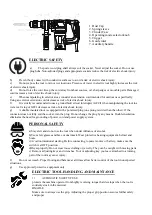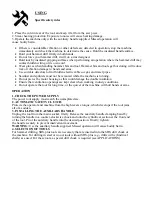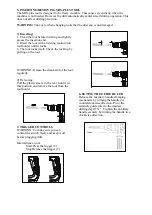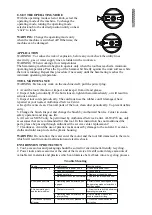
USING
Specific safety rules
1
.
Place the cord in rear of the tool, and keep it far from the saw piece.
2.
Swear hearing protection. Exposure to noise will cause hearing damage.
3.
Operate the machine only with the auxiliary handle supplied. Missed operation will
cause bodily harm.
•
If there is considerable vibration or other defects are detected in operation, stop the machine
immediately and check the machine to determine the cause. Hold the insulated handle surface.
•
Hold your hammer drill firmly in both hands.
•
Do not force your hammer drill, it will do a was designed.
•
Hold tool by insulated gripping surfaces when performing an operation where the hammer
drill may
contact hidden wiring or its own cord.
•
Wear gloves when handling hammer bits and tool. Hammer bits and tools get hot during
will reduce
risk of vibration damage to hands and arms.
•
Use suitable detectors to find hidden electric cables or gas and water pipes.
•
Sawdust and splinters must not be removed while the machone is running.
•
Do not pierce the motor housing as this could damage the double insulation
•
Ensure that ventilation openings are kept clear when working in dusty conditions.
•
Do not operate the tool for long time, or the quiver of the machine will hurt hands or arms.
OPERATION
1.
CHECK THE POWER SUPPLY
The power tool supply must match the nameplate date.
2.
AUTOMATIC SAFETY CLUTCH.
Protects the operator and machine from the high reverse torque, which develops if the tool jams
all of a sudden.
3.
INSTALLING THE AUXILIARY HANDLE
Unplug the tool from the mains socket, firstly. Release the auxiliary handle clamping band by
turning the handle in a counter-clockwise chuck and onto the cylindrical section at the front end
of the tool. Pivot the auxiliary handle into the desired position. Finally, tighten
the handle securely to prevent inadvertent movement.
WARNING:
Use the auxiliary handle supplied. Missed operation will cause bodily harm.
4.
SELECTION OF TOOLS
For hammer drilling, SDS-plus tools are necessary that are inserted into the SDS drill chuck of
the machine. For drilling in steel or wood, tools without SDS-plus (e.g., drills with cylindrical
shafts) are used. For these tools, a special drill chuck is required (see APPLICATIONS).
Summary of Contents for HD302
Page 8: ......



































